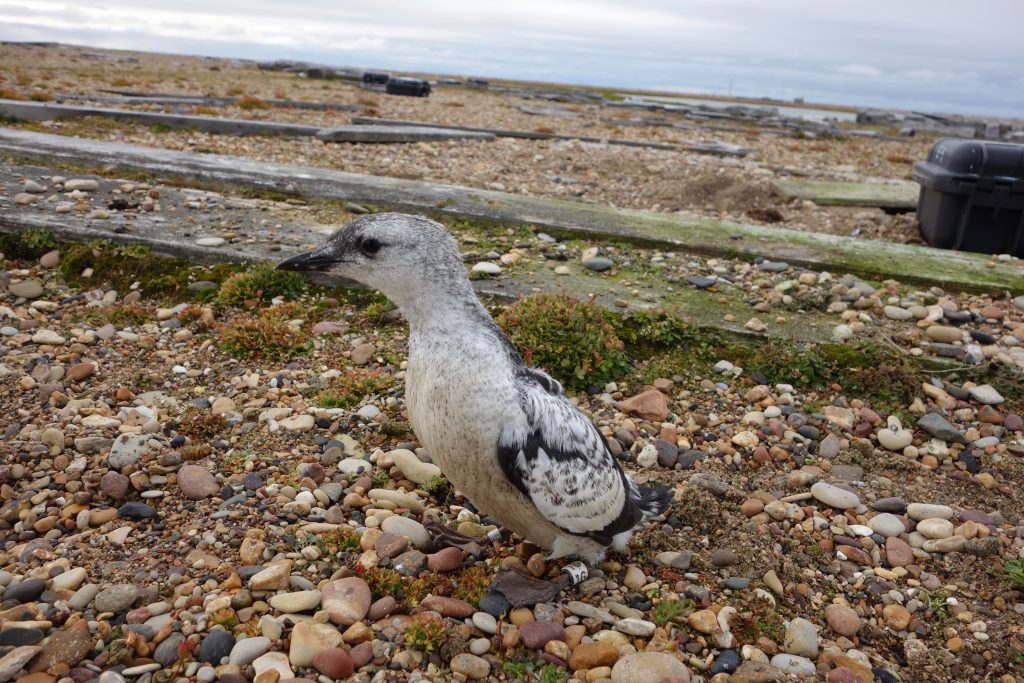by George Divoky

While much has changed over the course of the 45 summers I have spent on Cooper Island, as warming from anthropogenic carbon emissions has modified the Arctic’s snow and ice habitats, one thing has remained constant. The sun is always above the horizon for 24 hours when I arrive in early June and it does not set until precisely August 2.
The importance and impact of that constant daylight is hard to overstate. When I arrive on the island I am not constrained by the day-night/light-dark cycle that I just left in Seattle, and I can work on whatever schedule I like while setting up camp and conducting initial colony censuses. Equally important is the high serotonin level associated with the constant daylight, which increases the optimism one typically has when starting a field season at any latitude. That optimism is also amplified by seeing the guillemots, some of whom I have known for over two decades, initiate breeding.
After the sun sets in early August, “nighttime” for the following two weeks consists of an increasing twilight period until the third week of the month, when the sky becomes dark for the first time since before my arrival. The loss of daylight is the first clear signal that the summer is ending. Despite the major impact on fieldwork and my psychological state, I used to welcome the arrival of August darkness as it allowed the guillemots to complete their breeding season. Black Guillemot young fledge under the cover of darkness. After 35 days in a nest cavity, the chicks depart the colony independent of their parents. They fly off at the darkest time of night and quickly move offshore to reduce the risk of predation by diurnal shoreline predators like gulls, jaegers or falcons.
In recent years, however, the darkness of August has been a different experience for both the colony and for me. In the first two decades of the study, when the colony was almost three times its current size and breeding success was high, large numbers of nestlings would fledge every night. My dawn nest checks during those years found many just-vacated nesting cavities which provided daily evidence of that year’s breeding success and the promise that future breeding seasons would see large numbers of birds returning to their natal colony on Cooper Island.
However, the period of August darkness became quite different as the Arctic warmed. Starting in 2002, when annual summer sea ice melt notably increased, we began to see polar bears on Cooper Island. Polar bears on land are active during the nighttime hours and it was not uncommon to wake up in late August to find that bears had flipped over the wooden nest boxes and consumed guillemot chicks, sometimes wiping out half of the colony in one night. We addressed bear predation by replacing the wooden nest boxes with bear-proof plastic cases in 2012, but the continuing loss of ice that drives the bears to land each summer is also making the guillemots’ preferred ice-associated prey, Arctic cod, unavailable to parents for feeding their young.
In the 2019 breeding season that is just ending, decreased prey availability due to both a lack of sea ice and high sea water temperature underlie the death of 75 percent of the nestlings. While hatching success was good, only 25 percent of the 130 nestlings survived until late August. In past years when sea ice was just offshore and Arctic cod were abundant, over 75 percent of the nestlings would be expected to fledge. This year’s nestling mortality occurred mainly in late July and early August, when nearby ocean waters were so warm (up to 9 C or 48 F) that even the less preferred alternative prey, sculpin, were scarce. Guillemots typically have two-chick broods with the younger chick being fed less during periods of low prey abundance. This year none of the younger siblings survived past early August, the first year without bear predation that no pair was able to fledge two chicks.
The small number of surviving nestlings are now fledging. Having monitored them since they were eggs, including weighing them daily during the five-week nestling period, I have come to know them as individuals and am pleased when I open a nest case to find the surviving chick had left the previous night. But I am also aware that the extremely low breeding success this year, coupled with similar low success in the past two years, will cause the number of breeding pairs in the colony to continue to decline. Although the few chicks that have fledged in recent years can be expected to return to Cooper Island in two to three years, if they survive the ongoing loss of ice in their winter habitat in the Bering Sea, realistically the Cooper Island colony of Black Guillemots can never be expected to regain its past numbers nor its past success.
In earlier years both the bright start of a field season, as birds laid their eggs, and the darkness of late summer, when chicks would fly off into the night, could raise one’s spirits. This year, the darkness of August has been a period of melancholy and uncertainty of how long the colony might persist.